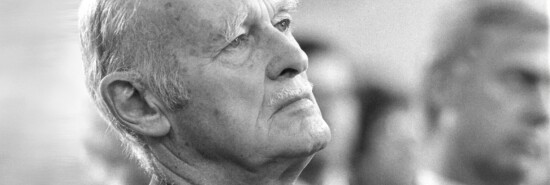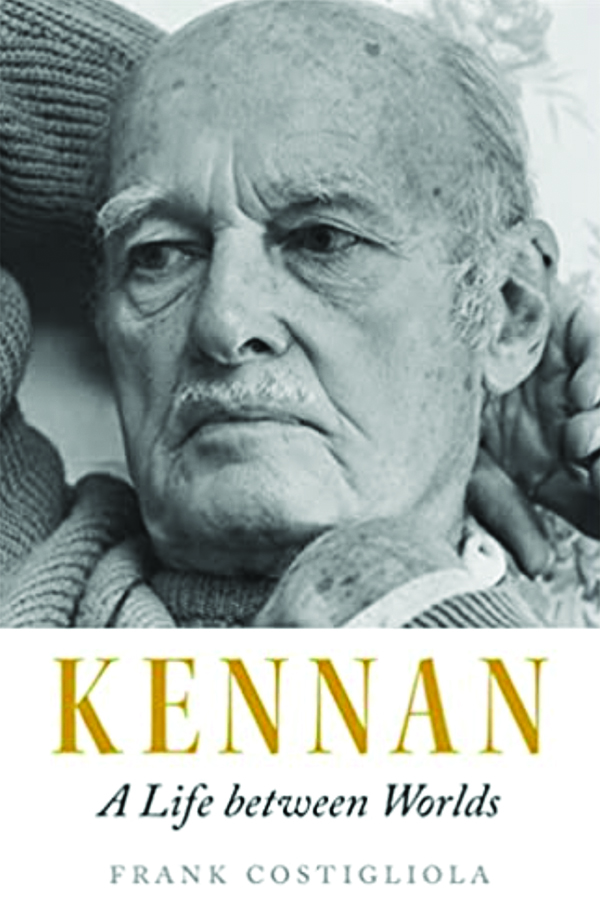
The divided George Kennan
Damir Marusic
George Frost Kennan’s status as a major figure in world history comes from his role in crafting postwar foreign policy, making him a sort of founding father of the American century. A diplomat whose famous “long telegram” of 1946 and subsequent “X article” for Foreign Affairs magazine in 1947 erected the intellectual scaffolding for the so-called “containment” doctrine, he spent half of his life repudiating his greatest achievement. He despaired that he had been misunderstood — that the Cold War need not have been as militarized as it had been. He was haunted by the all-too-real prospect of nuclear Armageddon and was a powerful advocate for a policy of “disengagement,” wherein both the Soviet Union and the United States would pull back their troops from Europe, leaving it a neutral space rather than a divided field of contestation.

He memorably testified against the Vietnam War before the Senate Foreign Relations Committee in 1966, an establishment Cold Warrior arguing that the misapplication of containment was yielding senseless slaughter in Indochina. And he was an early environmentalist, worried that a mindless devotion to technological progress was irreparably damaging not just nature itself but mankind’s ability to relate to the world meaningfully.
“The debate in America between idealism and realism, which continues to this day, played itself out inside Kennan’s soul,” remarked Henry Kissinger in his review of John Lewis Gaddis’s magisterial 2011 authorized biography, George F. Kennan: An American Life. Kennan is usually thought of as a progenitor of the American “realist” school of foreign policy, which claims to eschew sentimental and emotional considerations in favor of a more detached attempt to calculate interests — both one’s own and of one’s adversary. But the thing about Kennan is that he was not really a realist — at least not one in the mold of Kissinger. He was a tragic, torn figure who represented two competing tendencies. And, indeed, we do him some injustice by focusing merely on the hardheaded analysis that helped lay the groundwork for the Cold War.
The final pages of Frank Costigliola’s important new book, Kennan: A Life Between Worlds, relate to his subject’s acute anxiety about his legacy. With access to diaries and correspondence, which have been opened to the public since Kennan’s death in 2005, Costigliola reveals his elderly protagonist in frenzied correspondence with Gaddis, in turns worried that the Cold War historian would either not write the book that he had promised, or, worse, would not do full justice to his thinking. As with many of his intuitions, Kennan was right to be worried, but perhaps for the wrong reasons. Gaddis’s definitive tome was comprehensive, but it understandably dwelled on Kennan’s successes in shaping the Cold War more than on his subsequent contrarianism. It made Kennan out to be the great man he undoubtedly was by skillfully situating his role in the great drama of the 20th century. But in doing so, it accentuated one side of the man, the incisive Cold War intellectual, over the other, the passionate activist. Costigliola’s effort may be more in line with what Kennan would actually have hoped for. But the warts-and-all scrutiny enabled by the release of the private papers surely would have stung the neurotic and vain Kennan that emerges from the pages of Costigliola’s new book.
The “two worlds” of Costigliola’s subtitle contains a double meaning. It refers above all to Freud’s two forces in Civilization and Its Discontents: “Eros” and “civilization.” Kennan apparently first encountered the book while in a sanatorium in Austria in 1935, where he was recovering from a nervous breakdown due to overwork while serving in the American Embassy in Moscow. The idea of the book, that modern man is being torn asunder by the demands of unbridled individuality on the one hand and the demands of a staid social order on the other, profoundly influenced him and kept popping up in his private writings thereafter. Kennan lost his mother at an early age, and he imagined that his own birth had caused her demise. He returns to this tragedy throughout his life and grapples with his own rampant drives to marital infidelity through a Freudian lens. More importantly, Costigliola shows how much Kennan’s “pop psychology” obsession helped shape the analysis that he proffered. It’s impossible to unsee Freud’s hand in both the long telegram and the X article once it has been pointed out — in Kennan’s speculative but ultimately prescient analysis of the Soviet mindset.
But Freud offers no infallible framework for understanding the world. And Kennan’s overapplication of his own psychoanalytical intuitions doomed his career at its apex. Costigliola spends a chapter chronicling Kennan’s puzzlingly short tenure as ambassador to Moscow between 1951 and 1952. His ambassadorship was terminated when he was quoted by a journalist clumsily comparing the Soviet Union to Nazi Germany while on an official trip to Berlin — an unforgivable offense to a people who endlessly lionize their prodigious sacrifices during World War II. But Kennan’s credibility was shot well before that outburst due to a series of cables back to Washington speculating on the psychology of the Kremlin’s inner circle and its willingness to compromise. The self-important tone and the groundless assertions backed only by appeals to his authority on all Soviet matters made the former sage into a bit of an embarrassment back at headquarters, even among acolytes. Realist analysis, this is not.
The other meaning of the “two worlds” in the book’s title refers, broadly, to America and Russia. On the one hand, he passionately hated much of what constituted the modern America of his time. He loathed how over-democratized it was and harbored lasting bigotries against women, black people, and Jews. The idealized, pastoral vision of the country of his grandfather’s time was coming apart and could only be restored through a program of national self-discipline and authoritarian leadership by wise patricians (such as himself). On the other, he idealized the Russian people, imparting to them an essential goodness and spirituality that was being repressed by the odious Stalinist regime. He spoke Russian like a native, imbibed high and low Russian culture at every opportunity, and positively relished interacting with all social classes of Russian citizens. Stalin’s purges so infuriated him that they arguably pushed him into the brief phase of hawkishness in the late 1940s — the phase that he spent the rest of his life repudiating.
Being trapped between two worlds certainly gave Kennan important insights at times. But it also blinded him at others. Neither pastoral America nor spiritual Russia ever existed as they did in Kennan’s imagination. As a result, he was often indulgent of, if not outright credulous about, Soviet proposals for deescalation in the Cold War while at the same time being rigidly dismissive of American statesmanship as senselessly militaristic. Kissinger has mused about how the tussle between realism and idealism in American foreign policy has worked out for the best. It may work on the level of the state; in a person, however, the results are decidedly more mixed.
Costigliola’s book is a valuable contribution to understanding Kennan for who he really was — and the very real limits of his abilities. My own feelings upon completing the book echo those of Owen T. Jones, an economic adviser serving under Kennan in Belgrade in the early 1960s.
“Kennan has the touch of greatness about him,” which “had an immediate effect on me.” As Jones got to know “the great man,” awe dimmed into ambivalence. “I am attracted to Kennan’s essential kindness and decency, his brilliance,” and the “long-term soundness of his judgments,” he wrote a year later. “I am repelled by his self-centered egoism,” “his mercurial moods, his intellectual arrogance, his arm’s length treatment of myself as virtually a rival,” and, in general, “the unevenness of his performance.” Kennan’s was a mind “brilliant but not flexible.”
Costigliola notes as an aside that this is a “tough but fair appraisal.” The same can be said of Costigliola’s new book, a valuable entry and one that leaves the reader glad that Gaddis’s authorized biography is not the last word on George Kennan.
Damir Marusic is a senior fellow at the Atlantic Council and the co-founder of Wisdom of Crowds.
